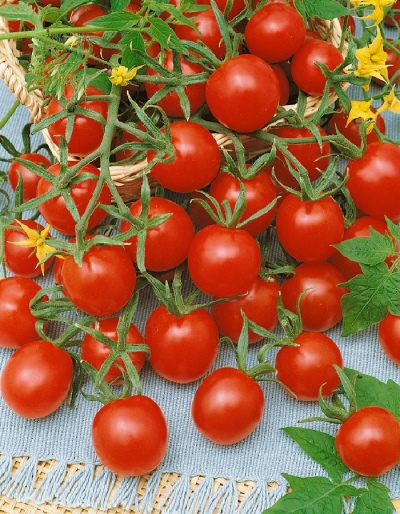
- Authors: Domanskaya M.K., Gubko V.N., Orlova E.A., Salmina I.S., Chernovolova O.A., Dmitrienko A.E.
- Year of approval: 2009
- Category: grade
- Growth type: indeterminate
- Appointment: universal
- Ripening period: early
- Ripening time, days: 95-105
- Growing conditions: for open ground, for film greenhouses
- Transportability: good
- Bush size: tall
You can decorate a garden bed by planting exotic tomatoes that are not only aesthetically attractive, but also delicious. These include the early ripe cherry tomato Shalun, productive both in the open field and in the protected.
Breeding history
Shalun tomatoes were created by a group of Russian breeders (I. Salmina, A. E. Dmitrienko, O. A. Chernovolova, V. N. Gubko and M. K. Domanskaya) in 2007. Two years later, in 2009, the culture was entered into the State Register of Breeding Achievements, and also allowed for use. It is recommended to grow vegetables in all regions of the country. In the southern and central parts, it can be planted in a garden bed, and in colder regions - in a film greenhouse.
Description of the variety
Tomato Shalun is a tall plant of an indeterminate type, growing up to 200 cm. The culture is characterized by weak thickening of small green leaves, a strong central stem and flexible branches with a noticeable edge, a developed root and complex inflorescences. A healthy bush is hung with weighty fruit clusters. Up to 30 mini-berries are tied in each fruit cluster.
When growing a vegetable crop, it is necessary to form bushes in 1-2 stems, be sure to tie them to supports or trellises, and also regularly remove unnecessary stepsons. Due to the fact that the foliage is weak, there is no need to thin out the foliage.
The purpose of tomatoes is universal, so they are eaten fresh, processed into juices and pastes, widely used in cooking, pickled and canned. Whole fruit canning is especially important.
The main qualities of the fruit
Cherry tomatoes Shalun belong to the small-fruited class. The average weight of a berry is 11 grams, but sometimes tomatoes grow up to 15-20 g. The shape of the berries is obovate with a perfectly smooth surface. Ripe cherry is evenly colored in a rich crimson color, and at the stage of technical maturity - in green. The peel of the berries is dense, shiny, not rigid. Due to the density of the skin, vegetables have resistance to cracking. In addition, tomatoes are transportable and have a long shelf life.
Taste characteristics
Tomatoes are characterized by excellent taste and excellent marketability. The pulp of the berries has a moderate density, meatiness and sufficient juiciness. The taste is harmonious, dominated by sweetness, complemented by light sugar content and spicy aroma. There are few seeds in the pulp.
Ripening and fruiting
Shalun is an early tomato, therefore, from the moment of mass germination of seedlings to ripe berries on the brushes, only 95-105 days pass. The fruiting period is extended, which will allow you to enjoy ripe berries for a long time. The phase of active fruit ripening occurs in July-August. Ripe tomatoes can hang on bunches for a long time without crumbling.
Yield
The yield of this early maturing species reaches 3.9 kg of tomatoes per 1 m2, the main thing is to follow the basic agrotechnical rules.When growing a crop in a greenhouse, the yield will be slightly higher - 4.2-4.9 kg per 1 m2.
The timing of planting seedlings and planting in the ground
Tomato is grown through seedlings. Seeds are sown in late March - early April. They are pre-sorted, checked for suitability, disinfected and treated with a growth stimulant. Mass germination occurs on the 5-7th day. For further growth, it is necessary to ensure the correct temperature and light conditions.
Diving is carried out at the stage when 2-3 leaves appear on the bushes. After planting, the seedlings should be watered and fed. A week before transplanting, the bushes are hardened, which will facilitate the adaptation of seedlings to new climatic and soil conditions.
Landing in a garden or greenhouse is carried out in the second half of May - early June. At this point, the bushes at the age of 55-60 days have 5-7 leaves and a flower brush.

Growing tomato seedlings is an extremely important process, because it largely depends on whether the gardener will be able to harvest at all. All aspects must be taken into account, from seedbed preparation to planting in the ground.
Landing scheme
To grow healthy tomatoes, you need to plant them correctly in the garden, which will provide sufficient oxygen and light to the plants. It is recommended to plant no more than 3 bushes per 1 m2. The correct layout for planting is 70x40 cm.

Growing and care
The variety does not require special care, but is whimsical to the soil. The soil should be loose, breathable, moisture-permeable and fertile. In addition, the site should be abundantly illuminated by the sun, since Shalun tomatoes are thermophilic. The best for growing will be the area where zucchini, radish or pumpkin previously grew.
Comprehensive crop care consists of regular watering with warm water, weeding the beds, applying fertilizers, forming, pinching and tying bushes, ventilating the greenhouse, as well as preventive measures to protect against pests and viruses.




A plant needs different micronutrients at each stage of growth. All fertilizers can be divided into two groups: mineral and organic. Folk remedies are often used: iodine, yeast, bird droppings, eggshells.
It is important to observe the rate and period of feeding. This also applies to folk remedies and organic fertilizers.
Disease and pest resistance
Immunity provides tomato protection against some diseases - late blight and tobacco mosaic virus.


Resistant to adverse weather conditions
Stress resistance makes the tomato resistant to temperature extremes, short-term drought and heat.

























































































